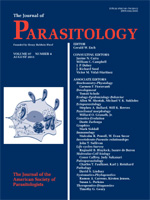Amyloodinium ocellatum is a parasitic dinoflagellate that infects warm-water marine and estuarine fishes and causes mortalities in aquaculture. Its life cycle consists of 3 stages: a feeding trophont that parasitizes the gills and skin where it interferes with gas exchange, osmoregulation, and tissue integrity; a detached reproductive tomont; and a free-swimming infective dinospore. We compared the susceptibility and tolerance of juvenile spotted seatrout, Cynoscion nebulosus, and red snapper, Lutjanus campechanus, to this parasite by individually exposing fish in 3-L aquaria (at 25 C and 33 practical salinity units) to several dinospore doses over different time periods and quantified the size and number of resulting trophonts. We estimated the trophont detachment rate and trophont size at detachment, the 24-hr dinospore infection rate, the dinospore 48-hr median lethal dose (LD50), and the trophont lethal load at the 48-hr LD50. There were no significant differences in dinospore infection rates or dinospore lethal doses between spotted seatrout and red snapper; however, trophonts remained attached longer and attained a larger size in red snapper than in spotted seatrout. The trophont lethal load was significantly higher in spotted seatrout than in red snapper. A proposed model simulating the trophont dynamics reflected our experimental findings and showed that A. ocellatum reproductive success is linked both to the number of dinospores and the size of the trophont, factors that, in turn, are linked to the time the trophont spends on the host and the number of trophonts the host can tolerate.
BioOne.org will be down briefly for maintenance on 12 February 2025 between 18:00-21:00 Pacific Time US. We apologize for any inconvenience.
How to translate text using browser tools
1 August 2011
Susceptibility and Tolerance of Spotted Seatrout, Cynoscion nebulosus, and Red Snapper, Lutjanus campechanus, to Experimental Infections with Amyloodinium ocellatum
Ignacio Masson,
Reginald B. Blaylock,
Jeffrey M. Lotz
ACCESS THE FULL ARTICLE

Journal of Parasitology
Vol. 97 • No. 4
August 2011
Vol. 97 • No. 4
August 2011




